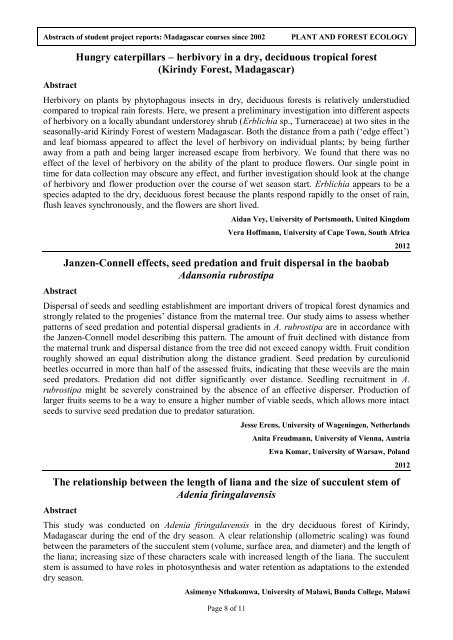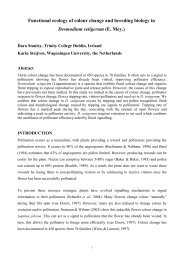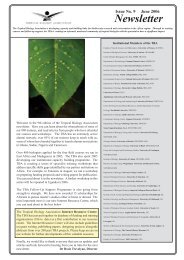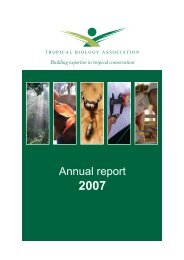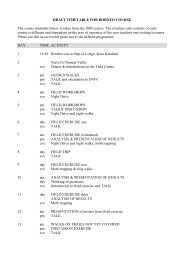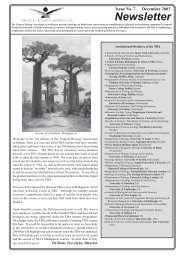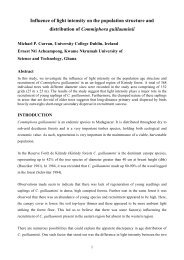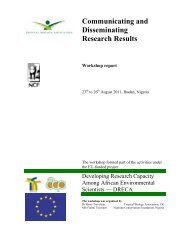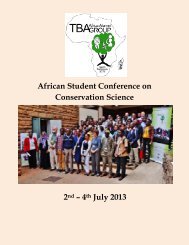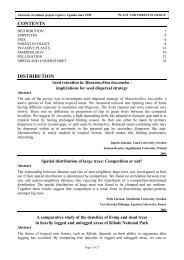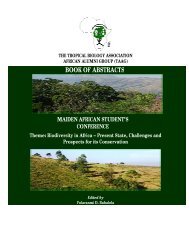Plant and forest ecology - Tropical Biology Association
Plant and forest ecology - Tropical Biology Association
Plant and forest ecology - Tropical Biology Association
You also want an ePaper? Increase the reach of your titles
YUMPU automatically turns print PDFs into web optimized ePapers that Google loves.
Abstracts of student project reports: Madagascar courses since 2002<br />
PLANT AND FOREST ECOLOGY<br />
Abstract<br />
Hungry caterpillars – herbivory in a dry, deciduous tropical <strong>forest</strong><br />
(Kirindy Forest, Madagascar)<br />
Herbivory on plants by phytophagous insects in dry, deciduous <strong>forest</strong>s is relatively understudied<br />
compared to tropical rain <strong>forest</strong>s. Here, we present a preliminary investigation into different aspects<br />
of herbivory on a locally abundant understorey shrub (Erblichia sp., Turneraceae) at two sites in the<br />
seasonally-arid Kirindy Forest of western Madagascar. Both the distance from a path (‘edge effect’)<br />
<strong>and</strong> leaf biomass appeared to affect the level of herbivory on individual plants; by being further<br />
away from a path <strong>and</strong> being larger increased escape from herbivory. We found that there was no<br />
effect of the level of herbivory on the ability of the plant to produce flowers. Our single point in<br />
time for data collection may obscure any effect, <strong>and</strong> further investigation should look at the change<br />
of herbivory <strong>and</strong> flower production over the course of wet season start. Erblichia appears to be a<br />
species adapted to the dry, deciduous <strong>forest</strong> because the plants respond rapidly to the onset of rain,<br />
flush leaves synchronously, <strong>and</strong> the flowers are short lived.<br />
Abstract<br />
Page 8 of 11<br />
Aidan Vey, University of Portsmouth, United Kingdom<br />
Vera Hoffmann, University of Cape Town, South Africa<br />
Janzen-Connell effects, seed predation <strong>and</strong> fruit dispersal in the baobab<br />
Adansonia rubrostipa<br />
Dispersal of seeds <strong>and</strong> seedling establishment are important drivers of tropical <strong>forest</strong> dynamics <strong>and</strong><br />
strongly related to the progenies’ distance from the maternal tree. Our study aims to assess whether<br />
patterns of seed predation <strong>and</strong> potential dispersal gradients in A. rubrostipa are in accordance with<br />
the Janzen-Connell model describing this pattern. The amount of fruit declined with distance from<br />
the maternal trunk <strong>and</strong> dispersal distance from the tree did not exceed canopy width. Fruit condition<br />
roughly showed an equal distribution along the distance gradient. Seed predation by curculionid<br />
beetles occurred in more than half of the assessed fruits, indicating that these weevils are the main<br />
seed predators. Predation did not differ significantly over distance. Seedling recruitment in A.<br />
rubrostipa might be severely constrained by the absence of an effective disperser. Production of<br />
larger fruits seems to be a way to ensure a higher number of viable seeds, which allows more intact<br />
seeds to survive seed predation due to predator saturation.<br />
2012<br />
Jesse Erens, University of Wageningen, Netherl<strong>and</strong>s<br />
Anita Freudmann, University of Vienna, Austria<br />
Ewa Komar, University of Warsaw, Pol<strong>and</strong><br />
The relationship between the length of liana <strong>and</strong> the size of succulent stem of<br />
Adenia firingalavensis<br />
Abstract<br />
This study was conducted on Adenia firingalavensis in the dry deciduous <strong>forest</strong> of Kirindy,<br />
Madagascar during the end of the dry season. A clear relationship (allometric scaling) was found<br />
between the parameters of the succulent stem (volume, surface area, <strong>and</strong> diameter) <strong>and</strong> the length of<br />
the liana; increasing size of these characters scale with increased length of the liana. The succulent<br />
stem is assumed to have roles in photosynthesis <strong>and</strong> water retention as adaptations to the extended<br />
dry season.<br />
2012<br />
Asimenye Nthakomwa, University of Malawi, Bunda College, Malawi


